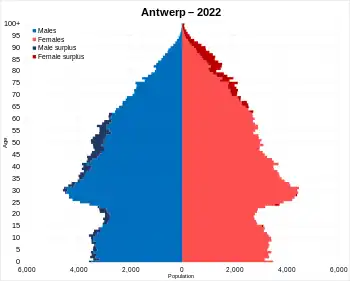Demographics of Antwerp
The demographics of Antwerp are monitored by Statistics Belgium. The population of the city as of 2022 is currently 530,630.[1]
| Demographics of Antwerp | |
|---|---|
 Population pyramid of Antwerp in 2022 | |
| Population | 530,630 (2022) |
Population
Population history of the city of Antwerp:
|
|

Growth rate
Antwerp as a city has grown and declined in population size throughout its history.
Age structure
The age structure of the city is as follows for 2022;
| Age structure[1] | 2022 | ||
|---|---|---|---|
| Under 18 | 18 to 64 | 65 and older | |
| Population | 119,762 | 324,378 | 86,490 |
| Percentage | 22.6% | 61.1% | 16.3% |
Fertility and births
In 2019, a total of 7,398 were born in total[14]
Gender
There are slightly more men in the city of Antwerp then females.[1]
| Gender structure | 2022 | |
|---|---|---|
| Men | Women | |
| Population number | 266,100 | 264,530 |
| Percentage | 50.15% | 49.85% |
Language
As in all Flemish provinces, the official and standard language of the Antwerp province is Dutch. As with Flemish Brabant, North Brabant and Brussels, the local dialect is a Brabantian variety.
Religion
The Religion of the City of Antwerp has historically been that of Roman Catholic. Due to modern migration however, there has been an introduction of non-Christian religions to the city such as the growth of Islam.
Origin
In 2010, 36% to 39% of the inhabitants of Antwerp had a migrant background.
| Nationality
(by citizenship) |
Population – 2020
(all districts)[15] |
| 415,747 | |
| 20,103 | |
| 11,780 | |
| 8,387 | |
| 6,221 | |
| 4,539 | |
| 4,376 | |
| 4,360 | |
| 4,131 | |
| 3,082 | |
| 3,043 | |
| 2,894 | |
| 2,389 | |
| 2,364 | |
| 2,322 | |
| 2,017 | |
| Others | 34,659 |
In 2022, 22% of the city did not have Belgian nationality (classified as a 'non-Belgian').[1]
| Group of origin | Year[16] | |||||||||
|---|---|---|---|---|---|---|---|---|---|---|
| 2001 | 2006 | 2011 | 2016 | 2023 | ||||||
| Number | % | Number | % | Number | % | Number | % | Number | % | |
| Belgians with Belgian background | 340,130 | 76.3% | 316,993 | 68.7% | 291,499 | 59.1% | 268,317 | 51.9% | 235,374 | 43.7% |
| Belgians with foreign background | 50,378 | 11.3% | 85,171 | 18.5% | 115,236 | 23.3% | 143,009 | 27.6% | 178,476 | 33.1% |
| Neighboring country | 10,344 | 2.3% | 11,911 | 13,387 | 14,820 | 17,132 | 3.2% | |||
| EU27 (excluding neighboring country) | 5,179 | 1.2% | 6,328 | 7,518 | 9,181 | 12,514 | 2.3% | |||
| Outside EU 27 | 34,855 | 7.8% | 66,932 | 94,331 | 119,008 | 148,830 | 27.6% | |||
| Non-Belgians | 55,062 | 12.3% | 59,332 | 12.9% | 86,782 | 17.6% | 105,716 | 20.4% | 125,060 | 23.2% |
| Neighboring country | 11,515 | 2.6% | 13,385 | 18,810 | 22,588 | 23,253 | 4.3% | |||
| EU27 (excluding neighboring country) | 7,130 | 1.6% | 9,215 | 18,557 | 28,197 | 33,109 | 6.1% | |||
| Outside EU 27 | 36,417 | 8.2% | 36,732 | 49,415 | 54,931 | 68,698 | 12.7% | |||
| Total | 445,570 | 100% | 461,496 | 100% | 493,517 | 100% | 517,042 | 100% | 538,910 | 100% |
References
- "Structure of the Population | Statbel". statbel.fgov.be. Retrieved 2022-07-15.
- "Antwerp timeline 1300–1399". Strecker.be. Archived from the original on 7 May 2008. Retrieved 13 April 2010.
- "Antwerp timeline 1400–1499". Strecker.be. Archived from the original on 10 May 2008. Retrieved 13 April 2010.
- Braudel, Fernand The Perspective of the World, 1985
- "Antwerp timeline 1500–1599". Strecker.be. Archived from the original on 2 May 2008. Retrieved 13 April 2010.
- Coornaert, Émile (1961). Les Français et le commerce international à Anvers : fin du XVe, XVIe siècle. Paris: Marcel Rivière et cie. p. 96.
- Boumans, R; Craeybeckx, J (1947). Het bevolkingscijfer van Antwerpen in het derde kwart der XVIe eeuw. T.G. pp. 394–405.
- van Houtte, J. A. (1961). "Anvers aux XVe et XVIe siècles : expansion et apogée". Annales. Économies, Sociétés, Civilisations. 16 (2): 249. Retrieved 12 December 2014.
- Description of the French Fury matter, see chapter 'Declaration of independence' in article 'William the Silent'
- "Antwerp timeline 1600–1699". Strecker.be. Archived from the original on 7 May 2008. Retrieved 13 April 2010.
- "Antwerp timeline 1700–1799". Strecker.be. Archived from the original on 4 August 2008. Retrieved 13 April 2010.
- "Antwerp timeline 1800–1899". Strecker.be. Retrieved 13 April 2010.
- "Antwerp timeline 1900–1999". Strecker.be. Archived from the original on 7 January 2008. Retrieved 13 April 2010.
- "Births and fertility | Statbel". statbel.fgov.be. Retrieved 2022-07-15.
- "Stad in Cijfers – Databank – Inwoners naar nationaliteit, leeftijd, (8 klassen) en geslacht 2020 – Antwerpen". Antwerpen.be. City of Antwerp. Retrieved 18 April 2020.
- "Origin | Statbel". statbel.fgov.be. Retrieved 2023-07-04.